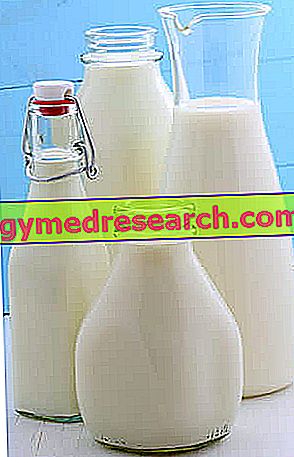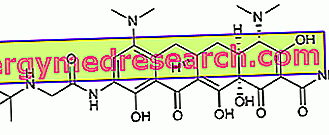Legal and product definition of milk
International Congress for the Repression of Food Fraud - Geneva 1908
Milk is the complete product of the complete and uninterrupted milking of a healthy dairy female, well fed and not fatigued. Milk coming from sick, malnourished animals and colostrum-containing milks are not suitable for human consumption (less than seven days after birth).
The milk must be collected correctly; it must be neither colored nor smelly; it must not contain pathogenic microbial species .
NB . In Italy, "milk" means exclusively the vaccine; otherwise it is essential that the different animal species on the product label, for example "buffalo milk", be specified.

Nutritional information
Milk is an organic product (intended as a biologically structured fluid and not as a disciplinary of food production), it is also a processing ingredient ... but above all it is a food !
Milk is an essential nutritional source for the initial growth of mammalian offspring; it is produced by the mammary gland of the females (emuntory gland) and its composition varies according to: species, stage of breastfeeding and individual variability. The milk is white and opalescent, has an almost neutral pH and its composition is extremely complex; it is in fact a lipid emulsion of globules immersed in a matrix similar to blood plasma. The aqueous portion also has some dissolved molecules (proteins), without which it is possible to isolate the so-called serum (neutral solution containing lactose and mineral salts).
From a chemical and nutritional point of view, milk is composed of:
- Lipids (especially triglycerides)
- Proteins (caseins, albumins and globulins)
- Glucides (lactose)
- Mineral salts (calcium, phosphorus, etc.)
However, what most influences the digestibility of milk is its composition in macronutritional energy molecules, that is only the first three categories of the four mentioned above.
Curiosity: milk is an extremely complex food! Milk is a real mixture; it is the mixture of many substances but all in reciprocal balance, which physically give rise to chemical-physical-compositional portions: emulsion, suspension, solution . The milk left at room temperature tends to separation, but it is certainly not a defect! It is sufficient to pause to think about the natural application of milk in nutrition, or from the squeezing of the breast directly to the digestive tract of the offspring; for this reason, there is no reason why milk should prepare itself for natural conservation. The separation process divides respectively: the cream (fat globules), the curd (coagulated casein proteins for microbial activity) and the serum (soluble portion of separation of the curd). The three portions just mentioned, in addition to distinguishing the macronutrients that characterize it, are also the starting point for dairy processing. |
Milk digestibility: introductory considerations
Milk is NOT a highly digestible food; it contains a large amount of water (which dilutes the digestive juices) and all the macronutrients, which require very different gastric pH conditions.
The digestibility of milk varies significantly based on:
- Sensitivity to lactose and its concentration in the product: delactosate milk is always more digestible than normal milk, but it also has a higher glycemic index
- Skimming level: the whole milk has more globules of fat (which must be digested) than the partially skimmed and skimmed one; for this reason it presents greater digestive difficulties
- Quantity of proteins: skimmed milk is more protein (albeit slightly) than whole milk; however, the lower presence of lipids gives it a digestive advantage such as to largely compensate for the greater need for gastric acid denaturation (protein difference oscillating between 1.8-2g / 100 of edible part)
Milk macronutrients, organic chemistry and digestibility
Glucides - lactose (4.7g out of 100g, in whole milk) : lactose is an exclusive component of milk and is not found in other naturally occurring foods. It is a simple glucide, more precisely a disaccharide formed by glucose + galactose. Lactose is found in different concentrations between the milk of different mammals and also in the different stages of lactation. Like other carbohydrates, it provides 3.75 kcal / 100g but its energy availability CAN be limited by individual tolerance; in this regard, we recall that lactose intolerance constitutes (together with gluten intolerance) the only clinically detectable intolerance with a certain reliability (using the H2 Breath-test).
The high incidence of lactose intolerance in the general population is convincing many people (professionals and laymen) that drinking milk after weaning is NOT a completely correct practice. In reality, lactose intolerance is determined by the (more or less important) deficiency of an enzyme located in the brush border of the intestine: lactase ( β-1, 4 galactosylase). NB. it is also possible to find rather serious symptoms related to another enzyme deficiency of a hepatic nature, the deficiency of galactase ( Galactose-1-phosphate uridiltransferase) . In this case it is more correct to speak of galactose intolerance.
In itself, not being able to hydrolyse lactose into glucose + galactose would not be a big problem, except that this disaccharide is an excellent substrate for bacteria in the colon; this fermentation phenomenon gives rise to a strong production of gas and hyperosmotic agents that attract water from the intestinal mucosa. This phenomenon can generate more or less intense enteric symptoms, which can vary depending on: the amount of milk ingested, the level of lactase deficiency, the fermentation potential of the colic bacterial flora and individual susceptibility. Note that lactose intolerance is prevalently prevalent in areas where milk has not been consumed for centuries, but on the contrary, it is rarer in traditionally pastoral areas. It is therefore obvious that the presence or not of lactase is influenced by many inter and intra individual variables, as well as by the genetic and family heritage; NB . also other pathological intestinal conditions (gastrointestinal infections) or morbid conditions (Crohn's, ulcerative rectocolitis, etc.), can negatively affect the presence of lactase in the mucosa.
Lactose has a glycemic index of 40-50, therefore, after hydrolysis, it is poured into the blood twice more slowly than glucose (glycemic index 100). This results in a lower impact on the insulin response favoring the control of lipogenesis. Moreover, in order to guarantee the maximum level of digestibility even in subjects intolerant to lactose, the food industry has started the production of a modified milk also called delattosate milk.
Lipids (3.6g + 11mg 100g, in whole milk): the most common compounds are triacylglycerols or triglycerides, which determine the physical properties of milk and act as solvents for other lipids or liposoluble molecules. Among the fatty acids esterified to glycerol there are abundant saturated ones, in particular short-chain α, which are more easily attacked by endogenous lipases resulting more digestible than other saturated fatty acids. Other lipid components of milk are phospholipids and sterols, and of these the most important is undoubtedly cholesterol (11mg / 100g of whole cow's milk). The lipidic or lipophilic substances of minor quantitative importance are: carotenoids (pro vitamin A), tocopherols (vit E), xanthophylls (similar to carotenoids), squalene (hydrocarbon triterpene) etc.
Milk fats are organized in emulsified globules in serum; the stability of this condition is favored by the structure of the globules themselves, characterized by a negatively charged external lipoprotein membrane. They have a variable diameter from 0.1 to 20 µm but in cow's milk, on average, they are between 2 and 6 µm. The average chemical composition of the globules is:
- Triglycerides 95.7%
- 2.3% Diglycerides
- 1.1% phospholipids
- 0.5% cholesterol
- Free fatty acids 0.3%
- Enzymes 0.1%
- Others <0.05%
Structurally, inside the blood cell there are glycerides with a low melting point (above all triglycerides), on average glycerides at medium melting point and externally a cortical area composed of phospholipids, triglycerides, cholesterol and lipoproteins.
Proteins (3.3g 100g, in whole milk): milk proteins can be divided into 3 groups ordered in a quantitatively decreasing manner. The first group consists of casein αs1, αs2, β and k, β-lactoglobulin, α-lactalbumin (89% of total nitrogen); the second group contains serum albumin, immunoglobulins, lactoferrin, proteoso peptone 3 and ceruloplasmin (2% of total nitrogen). The third group contains post-secretory proteolysis peptones, then γ casein (from β casein) and δ casein (from α casein; 3% of total nitrogen). Finally, a smaller part of the total nitrogen derives from nitrogenous substances of a non-protein nature.
Bibliography:
- Milk science - C. Alais - New techniques - pag 3: 5 - pag 19 - page 27
- Chemistry and milk technology - C. Corradini - New techniques - pag 57- pag 70



